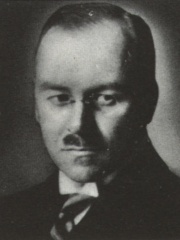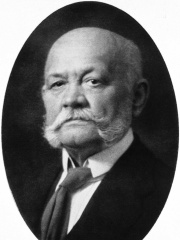







The Most Famous
CHEMISTS from Czechia
Top 9
The following people are considered by Pantheon to be the most legendary Czech Chemists of all time. This list of famous Czech Chemists is sorted by HPI (Historical Popularity Index), a metric that aggregates information on a biography's online popularity.

1. Gerty Cori (1896 - 1957)
With an HPI of 75.23, Gerty Cori is the most famous Czech Chemist. Her biography has been translated into 80 different languages on wikipedia.
Gerty Theresa Cori (née Radnitz; August 15, 1896 – October 26, 1957) was a Czech and American biochemist who in 1947 was the third woman to win a Nobel Prize in science, and the first woman to be awarded the Nobel Prize in Physiology or Medicine, for her role in the "discovery of the course of the catalytic conversion of glycogen". Cori was born in Prague, the capital of Bohemia within the Austro-Hungarian Empire. Growing up at a time when women were marginalized and allowed few educational opportunities, she gained admittance to medical school, where she met her future husband Carl Ferdinand Cori in an anatomy class. Upon their graduation in 1920, they married. Because of deteriorating conditions in Europe, the couple emigrated to the United States in 1922. Gerty Cori continued her early interest in medical research, collaborating in the laboratory with Carl. She published research coauthored with her husband, as well as publishing singly. Unlike her husband, she had difficulty securing research positions, and the ones she obtained provided meager pay. Her husband insisted on continuing their collaboration, though he was discouraged from doing so by the institutions that employed him. Together with her husband Carl and Argentine physiologist Bernardo Houssay, Gerty Cori received the Nobel Prize in 1947 for the discovery of the mechanism by which glycogen—a polysaccharide made from glucose—is broken down in muscle tissue into lactic acid and then resynthesized in the body and stored as a source of energy (known as the Cori cycle). They also identified the important catalyzing compound, the Cori ester. The Coris were the third ever married couple to win the Nobel Prize. In 2004, both Gerty and Carl Cori were designated a National Historic Chemical Landmark in recognition of their work in clarifying carbohydrate metabolism. In 1957, Gerty Cori died after a ten-year struggle with myelosclerosis. She remained active in the research laboratory until the end of her life. She received recognition for her achievements through multiple awards and honors.

2. Carl Ferdinand Cori (1896 - 1984)
With an HPI of 72.81, Carl Ferdinand Cori is the 2nd most famous Czech Chemist. His biography has been translated into 58 different languages.
Carl Ferdinand Cori, ForMemRS (December 5, 1896 – October 20, 1984) was a Czech-American biochemist and pharmacologist. He, together with his wife Gerty Cori and Argentine physiologist Bernardo Houssay, received a Nobel Prize in 1947 for their discovery of how the glucose derivative glycogen (animal starch) is broken down and resynthesized in the body for use as a store and source of energy. In 2004, both Coris were designated a National Historic Chemical Landmark in recognition of their work that elucidated carbohydrate metabolism.

3. Jaroslav Heyrovský (1890 - 1967)
With an HPI of 72.28, Jaroslav Heyrovský is the 3rd most famous Czech Chemist. His biography has been translated into 62 different languages.
Jaroslav Heyrovský (Czech: [ˈjaroslav ˈɦɛjrofskiː] ; 20 December 1890 – 27 March 1967) was a Czech chemist and inventor who received the Nobel Prize in Chemistry in 1959 for his invention of polarography.

4. Johann Josef Loschmidt (1821 - 1895)
With an HPI of 68.31, Johann Josef Loschmidt is the 4th most famous Czech Chemist. His biography has been translated into 37 different languages.
Johann Josef Loschmidt (15 March 1821 – 8 July 1895), better known as Josef Loschmidt, was an Austrian scientist who performed ground-breaking work in chemistry, physics (thermodynamics, optics, electrodynamics), and crystal forms. Born in Karlsbad, a town in the Austrian Empire (now Karlovy Vary, Czech Republic), Loschmidt became professor of physical chemistry at the University of Vienna in 1868. He had two early mentors. The first was Bohemian priest Adalbert Czech, who persuaded Loschmidt's parents to send young Josef to high school in the Piarist monastery in Schlackenwerth and, in 1837, to advanced high-school classes in Prague. This was followed by two years of philosophy and mathematics at Prague's Charles University, where Loschmidt met his second important mentor. This was philosophy professor Franz Serafin Exner, whose eyesight was failing, and who asked Loschmidt to be his personal reader. Exner was known for his innovative school reforms, which included promoting mathematics and science as important subjects. He suggested to Loschmidt, who became a close personal friend, that he apply mathematics to psychological phenomena. In the process of doing this, he became a very able mathematician. The era, when Loschmidt gradually developed his ideas on molecular structures, was to be a notable epoch in science. It was the time when the Kinetic Theory of Gases was being developed. His 1861 booklet, Chemische Studien ("chemical studies"), proposed two-dimensional representations for over 300 molecules in a style remarkably similar to that used by modern chemists. Among these were aromatic molecules such as benzene (C6H6), and related triazines. Loschmidt symbolized the benzene nucleus by a large circle, which he said was to indicate the yet-undetermined structure of the compound. Some have argued, however, that he intended this as the suggestion of a cyclical structure, four years before that of Kekulé, who is better known and is generally credited with the discovery of benzene's cyclic structure. In 1865, Loschmidt was the first to estimate the size of air molecules: his result was only twice the true size, a remarkable feat given the approximations he had to make. His method allowed the size of any gas molecules to be related to measurable phenomena, and hence to determine how many molecules are in a given volume of gas. This latter quantity is now known as the Loschmidt constant in his honour, and its modern value is 2.65×1019 molecules per cubic centimetre at standard temperature and pressure (STP). Loschmidt and his younger university colleague Ludwig Boltzmann became good friends. His critique of Boltzmann's attempt to derive the second law of thermodynamics from kinetic theory became famous as the "reversibility paradox". It led Boltzmann to his statistical concept of entropy as a logarithmic tally of the number of microstates corresponding to a given thermodynamic state. Loschmidt retired from university in 1891 and died in 1895 in Vienna.

5. Franz von Soxhlet (1848 - 1926)
With an HPI of 59.90, Franz von Soxhlet is the 5th most famous Czech Chemist. His biography has been translated into 18 different languages.
Franz Ritter von Soxhlet (12 January 1848 – 5 May 1926) was a German agricultural chemist and inventor.

6. Otto Wichterle (1913 - 1998)
With an HPI of 59.87, Otto Wichterle is the 6th most famous Czech Chemist. His biography has been translated into 23 different languages.
Otto Wichterle (Czech pronunciation: [ˈoto ˈvɪxtr̩lɛ]; 27 October 1913 – 18 August 1998) was a Czech chemist, best known for his invention of modern soft contact lenses. Wichterle was the author or co-author of approximately 180 patents and over 200 publications. The studies and independent books covered various aspects of organic, inorganic and macromolecular chemistry, polymer science, and biomedical materials. He held a higher number of patents for organic synthesis, polymerization, fibres, the synthesis and shaping of biomedical materials, production methods and measuring devices related to biomedical products. This was typical of his attitude to scientific research, which, he considered, ought to serve society and its requirements by any means possible, without distinction as to "pure" and "applied" science.

7. Hans Tropsch (1889 - 1935)
With an HPI of 59.18, Hans Tropsch is the 7th most famous Czech Chemist. His biography has been translated into 20 different languages.
Hans Tropsch (October 7, 1889 – October 8, 1935) was a chemist responsible, along with Franz Fischer, for the development of the Fischer–Tropsch process.

8. Zdenko Hans Skraup (1850 - 1910)
With an HPI of 55.89, Zdenko Hans Skraup is the 8th most famous Czech Chemist. His biography has been translated into 16 different languages.
Zdenko Hans Skraup (Czech pronunciation: [ˈzdɛŋko hans ˈskraup]; March 3, 1850 – September 10, 1910) was a chemist from Austria-Hungary, who discovered the Skraup reaction, the first quinoline synthesis.

9. Jiří Drahoš (b. 1949)
With an HPI of 52.06, Jiří Drahoš is the 9th most famous Czech Chemist. His biography has been translated into 16 different languages.
Jiří Drahoš (born 20 February 1949; Czech pronunciation: [ˈjɪr̝iː ˈdraɦoʃ]) is a Czech physical chemist and politician who has been the Senator of Prague 4 since October 2018. Previously, Drahoš served as President of the Czech Academy of Sciences from 2009 to 2017, and was a candidate in the 2018 Czech presidential election. Born in Český Těšín and raised in nearby Jablunkov, Drahoš studied physical chemistry at the University of Chemistry and Technology in Prague, and joined the Institute of Chemical Process Fundamentals of the Czechoslovak Academy of Sciences in 1973, which he later led from 1995 to 2003. In 2009, he was elected President of the Czech Academy of Sciences. His term as head of the academy ended on 24 March 2017. In March 2017, Drahoš announced his candidacy for President of the Czech Republic in the 2018 election. He ran on a moderate centrist platform, and is generally pro-European and supportive of NATO and Atlanticism. Drahoš lost the second round of the presidential election to his opponent President Miloš Zeman with 48.6% of the vote, but vowed to remain in public life. In October 2018, he stood for the Czech Senate in the Prague 4 district, winning the election outright in the first round with 52.65% of the vote. He is a member of the European Academy of Sciences and Arts.
People
Pantheon has 9 people classified as Czech chemists born between 1821 and 1949. Of these 9, 1 (11.11%) of them are still alive today. The most famous living Czech chemists include Jiří Drahoš. The most famous deceased Czech chemists include Gerty Cori, Carl Ferdinand Cori, and Jaroslav Heyrovský.
Living Czech Chemists
Go to all RankingsDeceased Czech Chemists
Go to all RankingsGerty Cori
1896 - 1957
HPI: 75.23
Carl Ferdinand Cori
1896 - 1984
HPI: 72.81
Jaroslav Heyrovský
1890 - 1967
HPI: 72.28
Johann Josef Loschmidt
1821 - 1895
HPI: 68.31
Franz von Soxhlet
1848 - 1926
HPI: 59.90
Otto Wichterle
1913 - 1998
HPI: 59.87
Hans Tropsch
1889 - 1935
HPI: 59.18
Zdenko Hans Skraup
1850 - 1910
HPI: 55.89
Overlapping Lives
Which Chemists were alive at the same time? This visualization shows the lifespans of the 8 most globally memorable Chemists since 1700.

